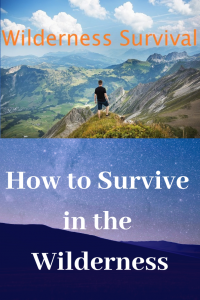Wilderness Survival Tips
When you go out in the wild, it is better to know how to manage! Survival in the forest is not a sport or activity in itself. It consists of techniques and actions that will keep you alive while waiting for help. Indeed, even when well prepared, an incident can occur. If the equipment fails you or you get lost or injured during a hike, you will be happy to master the basics of survival in the forest. Here are some tips that will help you cope in the event of an incident, but are not worthy of complete forest survival training.
Some tips that will help you

1 survival kit
In the wilderness, you should always keep certain items that could save your life in an emergency situation. This kit should take up a minimum of space. Ideally, you will put in a waterproof container the following items: waterproof matches in a waterproof package, a lighter, a water bottle, some lozenges to disinfect the water, a few cubes of broth and sugar / sweet candy sachets, at least one dressing, a needle, a whistle, a blanket, a rope, a fishing line, a small mirror, a flashlight, a compass and something to write about.
2 Drink
Hydration is essential for survival. If your reserves run out, you can drink the water you find in nature, but not just how! Beware of stagnant water (lake, marsh, etc.), which may make you sick. Rainwater, dew, slush and groundwater (which you find by digging the ground) are safer, but they should be boiled and ideally treated at the same time. Using a purification tablet before consumption.
3 Eat
Humans can survive up to three weeks without eating. However, he quickly loses his strength if he does not eat. Make your reserves last as long as possible, even if you have a hollow stomach. Then you can eat plants (berries, plants, nuts or mushrooms), but it is best to inquire a little before leaving, since some of your findings could be toxic. Bitter mushrooms, which produce a milky liquid, are not edible. On the other hand, you can safely eat ferns, cattail roots, reeds, tree nuts, tree bark and many other flowers and plants. Insects are also a good source of energy easy to find. Hunting and fishing are more complex, especially for a beginner. Remember that the wilderness sometimes is a very favorable ecosystem for survival; with imagination, you will always find something to eat.
4 Light a fire
To light a fire, nothing beats matches or a lighter. It is possible to light a fire even in very humid conditions. Waxed cardboard is a good fuel in wet weather. In addition, know that the bark of birch burns very well. Remember to protect the area where you fire your fire with stones, to avoid a fire. The methods to light a fire without matches or lighter, if they are not purely folkloric, are inefficient and tedious. Nothing beats the preparation!
5 Sheltering
If you have a blanket, you can build a makeshift shelter with it and a few tree branches. Otherwise, dig the ground and protect your hole as you can. In winter, building a snow shelter is better than staying in the open air.
6 Do not panic
The number one enemy of survival in kind is panic. If you have lost control over the situation, do not lose control of yourself at the same time. Try to stay calm and act rationally, whatever the cost.
When you decide to take a vacation in the middle of nature, it is better to be well prepared in the event of an incident. Whether you leave alone, with family or between adults, it is essential to bring a pharmacy kit. It is better to travel light, but in the event of a mishap, you will be happy to have planned the shot! Take care to transport liquid products in ergonomic, unbreakable plastic containers. Ideally, choose a waterproof fabric kit that is lighter than a metal box.
Contents of the kit
Sterilized water: it is better to clean the wounds with sterilized water. It is found in pharmacies, in the form of small plastic ampoules.
Disinfectant: Whether you choose a spray or wipes soaked in a product, the disinfectant will be useful in case of cut, scratch and even burn.
A small tweezers: it will prove very useful to extract a thorn or a thorn that would be buried under the skin.
Adhesive bandages of different sizes: choose waterproof ones and do not skimp on the quality of the product. The risk of infection is increased on the campsite, which is why it is important to cover the wounds well. Do not forget to bring bandages with blisters, especially if you are fond of hiking!
Bandages in various sizes, gauze, small scissors, and tape: in case of more severe injury, you will not be able to rely on simple adhesive bandages!
Surgical gloves: It is always recommended to use sterile gloves when handling a wound, to reduce the risk of infection.
Antibiotic ointment: This type of ointment helps prevent infections and often speeds up the healing process.
Calamine lotion: This product soothes minor burns, sunburns and insect bites.
Sunscreen and mosquito repellent: because prevention is always better than cure!
Tablets of different kinds: without lugging all the bottles of your pharmacy, have on you some of the most important tablets (painkiller, anti-inflammatory, anti-nausea, anti-diarrhea, antihistamine). Store them in a safe container or use a compartment pod (if you are worried about not knowing how to differentiate them from each other).

